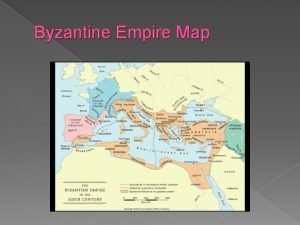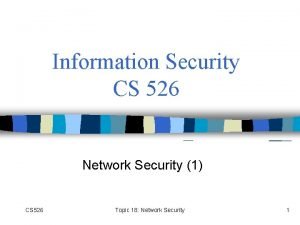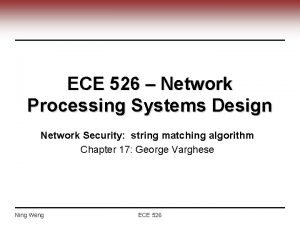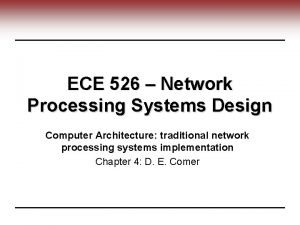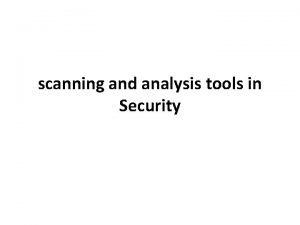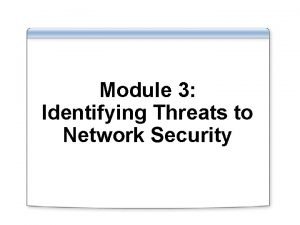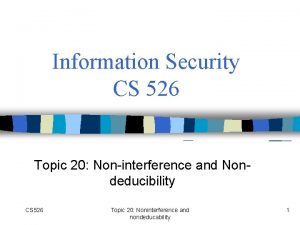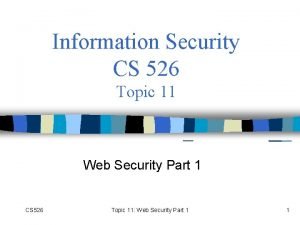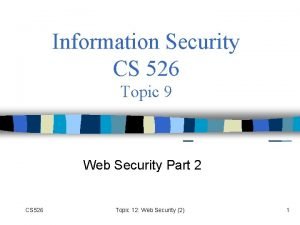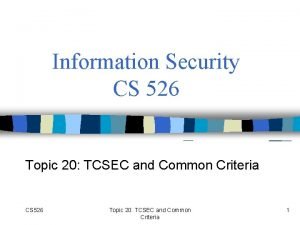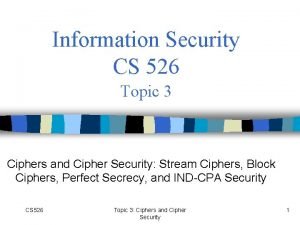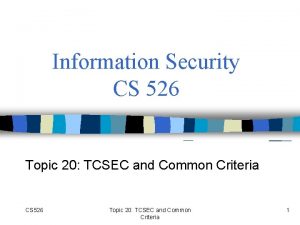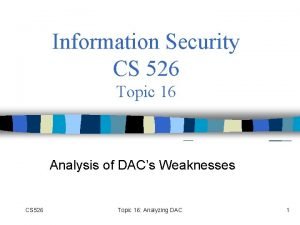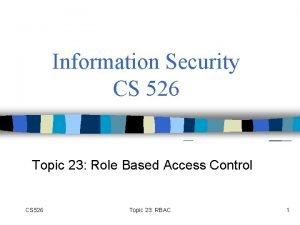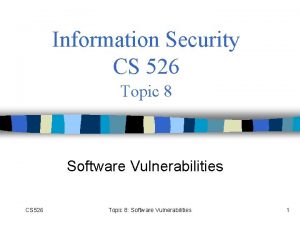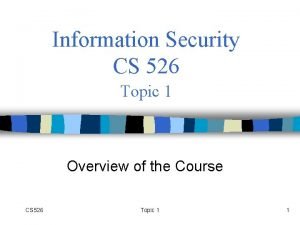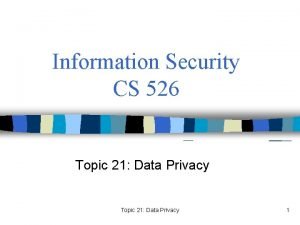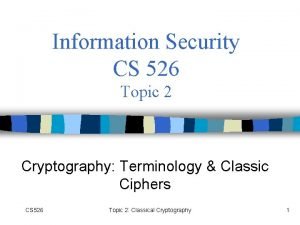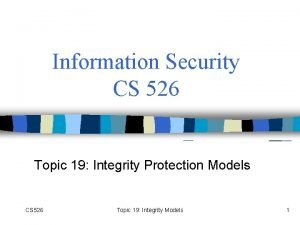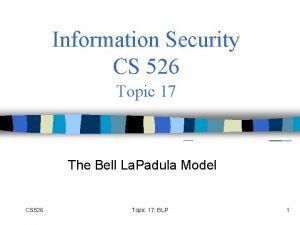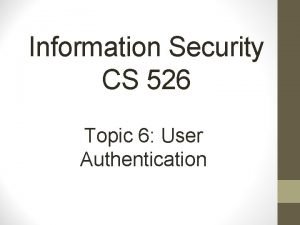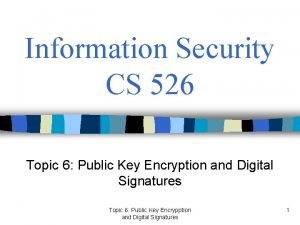Information Security CS 526 Topic 18 Noninterference and


















- Slides: 18

Information Security CS 526 Topic 18: Non-interference and Nondeducibility CS 526 Topic 18: Noninterference and nondeducability 1

Optional Readings for This Lecture • Security Policies and Security Models. J. A. Goguen and J. Meseguer. Oakland’ 1982 • Non-deducibility is from the paper “A Model of Information” by David Sutherland • Not available online CS 526 Topic 18: Noninterference and nondeducability 2

Motivations • Multi-level security is about information flow – Information in high level objects should not flow into low-level subjects • The BLP model describes access control mechanisms that prevents illegal information flow, but not the meaning of no illegal information flow – BLP describes “how”, not “what” for information flow protection • E. g. , define secure encryption by giving a particular encryption algorithm and say this is secure encryption – As a result, BLP does not prevent information flow through covert channels – Also, it doesn’t say whether other mechanisms can be used do information flow protection CS 526 Topic 18: Noninterference and nondeducability 3

Non-interference in Programs • Consider the following functions, is there information flow between x and output of the functions? add(int x, int y) { return x+y; } f(int x, int y) { if x>0 return y+y; else return 2*y; } check_pw(char *s) { char *x; return strcmp(x, s); } g(int x, int y){ return x*y/x; } CS 526 Topic 18: Noninterference and nondeducability 4

Deterministic Non-Interference in Programs • A set X of inputs is non-interfering with a set Y of outputs if and only if – No matter what values X take, the outputs Y remain the same • When one changes only values of inputs in X, the output remain unchanged • Observing only Y, one learns nothing about any input in X. – More formally, let Y=f(X, Z), where f is a deterministic function, and X, Z represents two sets of inputs, X is non-interfering with Y iff Z 0 Y 0 X 0 f(X 0, Z 0) = Y 0 or equivalently, Z 0 X 1 f(X 0, Z 0) = f(X 1, Z 0) – X interferes with Y iff. Z 0 X 1 f(X 0, Z 0) f(X 1, Z 0) • For randomized programs, non-interference is harder to define, and we do not cover it in this course CS 526 Topic 18: Noninterference and nondeducability 5

More on Non-interference Properties • Two classes of techniques to ensure that security properties are satisfied by programs – Monitor execution of a program and deny illegal actions or terminate the program if illegal action is detected. • Can enforce BLP property. • Cannot enforce non-interference. – Why? Because non-interference is not defined on one execution of a program; it is a property on a program’s behaviors on different inputs. – Statically verifying that certain non-interference relation holds by analyzing the program • Can be used only with access to source code CS 526 Topic 18: Noninterference and nondeducability 6

Language-Based Security • Using programming language technique to ensure certain security properties hold – A large body of work focuses on using type theory and compiling-time checks to ensure information-flow properties • Challenges to apply in real world: – Non-interference is often too strong • Suppose that one want to ensure that a secret password is not leaked, can one require non-interference between the password input and observable output? • Needs declassification mechanism that specify certain information dependent on sensitive inputs can be leaked. – Specifying such policies is impractical • Too much work for programmers, especially for large programs • Many policies need to be determined by end users, not programmers – Need source code, unable to deal with the real security challenge of external code. CS 526 Topic 18: Noninterference and nondeducability 7

The Non-Interference Model in the Original Goguen-Meseguer paper • A state-transition model, where state changes occur by subjects executing commands – – – S: set of states U: set of subjects SC: set of state commands Out: set of all possible outputs do: S×U×SC S • do(s, u, c)=s’ means that at state s, when u performs command c, the resulting state is s’ – out: S×U Out • out(s, u) gives the output that u sees at state s – s 0 S initial state Model focuses on interfaces (inputs/outputs) of a system, rather than internal aspects (e. g. , objects) CS 526 Topic 18: Noninterference and nondeducability 8

Security Policies in the Noninterefence Model • A security policy is a set of noninterference assertions • Definition of noninterference: Given two group of users G and G’, we say G does not interfere with G’ if for any sequence of commands w, – View_G’(w) = View_G’(PG(w)) • PG(w) is w with commands initiated by users in G removed. • No matter what users in G do, users in G’ will observe the same. • Implicit assumptions: – Initial state of the system does not contain any sensitive information – Information comes into the system by commands – Only way to get information is through outputs CS 526 Topic 18: Noninterference and nondeducability 9

Comparisons of the BLP work & the Noninterference work • Differences in model – BLP models internals of a system (e. g. , objects) – GM models the interface (input & output) • Differences in formulating security policies – BLP specifies access control requirement, noninterference specifies information flow goal – E. g. , under noninterference, a low user is allowed to copy one high-level file to another high-level file • In general not allowed by BLP • Noninterference could potentially address covert channels concerns – Provided that one defines observable behavior to include those in covert channels; this, however, makes the system description very complex, i. e. , it doesn’t make stopping covert channel easier CS 526 Topic 18: Noninterference and nondeducability 10

Evaluation of The Non-Interference Policy • The notion of noninterference is elegant and natural – Focuses on policy objective, rather than mechanism, such as BLP – Could be useful in other settings • Mostly concerned with deterministic systems – For randomized or otherwise non-deterministic systems, definition is more complicated • May be too restrictive – e. g. , consider encrypt and then communicate CS 526 Topic 18: Noninterference and nondeducability 11

Non-deducibility • Attempt to define information flow in non-deterministic as well as deterministic systems • Intuition: there is no information flow between X and Y, iff. , when observing only Y, one can never eliminate any value from the domain in X as a possible value • Definition: let Y=f(X, Z), where f is not necessarily deterministic, there is information flow between X and Y in the non-deducibility sense iff. Y 0 { f(X, Z) } X 0 s. t. Y 0 { f(X 0, Z) } – When one observes the value of Y is Y 0, one learns that X≠X 0. – There is no information flow between X and Y in the non-deducibility sense when Y 0 { f(X, Z) } X 0 Z 0 s. t. Y 0 { f(X 0, Z 0) } • Go to the examples for non-interference CS 526 Topic 18: Noninterference and nondeducability 12

An Example Illustrating that Nondeducibility is Too Weak • A high user and a low user – the high user can write to a file • one letter at a time – the low user can try to read the n’th character in a file • if file is shorter than n, or if the n’th character is blank, returns a random letter • otherwise, with 99. 9% probability return the letter, and with 0. 1% probalility return a random letter • The system is nondeducible secure • The system is intuitively insecure • Non-deducibility can often be too weak. It deals with possibilistic inference, not probabilistic inference CS 526 Topic 18: Noninterference and nondeducability 13

Examples: High int x = …; High int y = …; Low int z; if x>0 z = y+y; else z = 3*y; • x interferes with z • y interferes with z • x and z are not nondeduciable secure • y and z are not nondeduciable secure CS 526 High int x = …; High int y = …; Low int z; if x>0 z= y+y; else z=2*y; • x does not interfere with z • y interferes with z • x and z are nondeduciable secure • y and z are not nondeduciable secure Topic 18: Noninterference and nondeducability 14

Examples High int x = …; High int y = …; Low int z 1 = x + y; Low int z 2 = x – y; High char * x = …; Low char * entered_pw = …; Low boolean z; z = strcmp(entered_pw, x); • x interferes with z 1 • x interferes with z 2 • x and {z, entered_pw} are not non-deduciable secure • x and z 1 are nondeduciable secure • x and {z 1, z 2} are not nondeduciable secure CS 526 Topic 18: Noninterference and 15 • nondeducability

Relationships Between Nondeducibility & Noninterference • For deterministic systems with just one high input var (and possibly many other low input vars) and one low output, a system is noninterference secure if and only if it is nondeducibility secure. • For deterministic systems with more than one high input vars, non-interference is stronger than non-deducibility CS 526 Topic 18: Noninterference and nondeducability 16

Proof. • Theorem: For deterministic programs with just one high input variable x, let Z be the set of all low variables, x does not interfere with the set Z if and only if x and Z are nondeducible secure. • Proof. If x does not interfere with Z, no matter what values x takes, the variables in Z are uniquely determined by inputs in Z. Observing values in Z cannot eliminate any value for x. • If x interferes with Z, then there exist x 1≠ x 2 and Z 2≠Z 1 such that Z=Z 1 when x=x 1 and Z=Z 2≠Z 1 when x=x 2. Observing Z=Z 2, one knows x≠x 1, making x and X not nondeduciable secure. This is because as x is the only high var and the system is deterministic, when fixing input variables in Z to values in Z 2, the output variables are fixed as well. CS 526 Topic 18: Noninterference and nondeducability 17

Coming Attractions … • Integrity Models CS 526 Topic 18: Noninterference and nondeducability 18
 Noninterference model
Noninterference model Private securty
Private securty Byzantine empire 526 ce
Byzantine empire 526 ce Silicone logo
Silicone logo Byzantine empire 526 ce
Byzantine empire 526 ce What is the value of the underlined digit 526
What is the value of the underlined digit 526 Entao minh'alma canta a ti senhor salmo
Entao minh'alma canta a ti senhor salmo Network security process
Network security process Ece 526
Ece 526 Ece 526
Ece 526 Ece 526
Ece 526 Visa international security model
Visa international security model Cnss security model คือ
Cnss security model คือ General topic example
General topic example Research problem example for students
Research problem example for students Wireless security in cryptography and network security
Wireless security in cryptography and network security E commerce security meaning
E commerce security meaning Scanning and analysis tools are used to pinpoint
Scanning and analysis tools are used to pinpoint Module 3: information and network security
Module 3: information and network security




